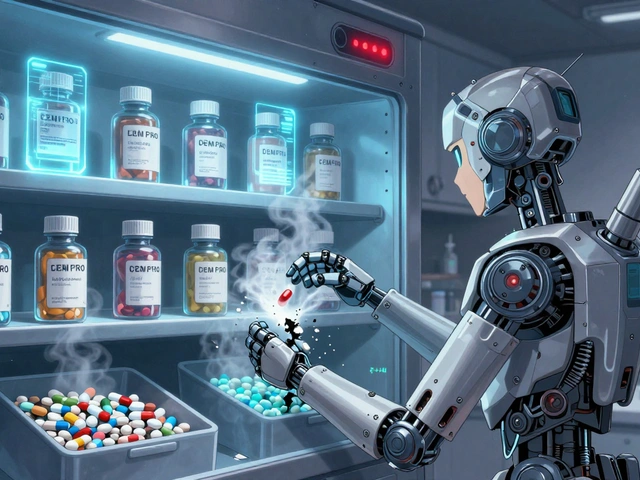When you take a medication like warfarin, levothyroxine, or digoxin, even a tiny change in how much of the drug gets into your bloodstream can mean the difference between effective treatment and a life-threatening problem. These are narrow therapeutic index drugs - and they demand much stricter rules when generic versions are made. Unlike most pills where a 20% variation in absorption is acceptable, NTI drugs can’t afford that kind of wiggle room. That’s why regulatory agencies like the FDA, EMA, and Health Canada have put in place bioequivalence standards that are far more demanding than those for ordinary generics.
What Makes a Drug a Narrow Therapeutic Index (NTI) Drug?
A narrow therapeutic index means the gap between a drug’s effective dose and its toxic dose is very small. The FDA uses a therapeutic index of 3 or less as the cutoff - meaning the toxic dose is only three times higher than the effective dose. For comparison, most common medications have a therapeutic index of 10 or higher. That’s why drugs like phenytoin for seizures, lithium for bipolar disorder, or tacrolimus for transplant patients are classified as NTI. A slight drop in blood levels could trigger a seizure or organ rejection. A slight increase could cause poisoning, kidney damage, or dangerous bleeding.
These drugs aren’t rare. About 35 medications fall into this category in the U.S., with annual sales topping $45 billion. Yet, despite their importance, generic versions have been slow to catch on. Many doctors and patients still prefer brand names out of caution. But the science shows that when generics meet the right standards, they’re just as safe.
Why Standard Bioequivalence Rules Don’t Work for NTI Drugs
For most generic drugs, regulators accept bioequivalence if the generic’s blood concentration is within 80% to 125% of the brand-name drug. That’s called the 80-125% rule. It works fine for drugs like ibuprofen or metformin, where small differences don’t matter much. But for NTI drugs, that range is too wide. A 25% drop in warfarin levels could lead to a clot. A 25% spike could cause internal bleeding. That’s why regulators had to rethink the rules.
Early studies in the 1990s and 2000s showed that some generic versions of NTI drugs had slightly different absorption patterns - not because they were poorly made, but because small changes in formulation, manufacturing, or even the shape of the pill could affect how quickly the drug entered the bloodstream. For drugs like levothyroxine, where the body is extremely sensitive to thyroid hormone levels, even a 5% difference can push a patient out of the therapeutic window. That’s why agencies moved from the standard 80-125% to tighter limits.
How Different Agencies Handle NTI Bioequivalence
Not all regulatory bodies use the same rules. The FDA, EMA, and Health Canada each took different paths - and their approaches reflect different scientific priorities.
The European Medicines Agency (EMA) went with a fixed, tighter range: 90-111% for both AUC and Cmax. It’s simple, clear, and easy to apply. If a generic falls outside that range, it’s rejected. This approach works well for drugs with low variability, but it can be overly strict for drugs with naturally high variability in how patients absorb them.
Health Canada uses a slightly wider range: 90.0-112.0% for AUC in critical dose drugs. Like the EMA, it sticks to fixed limits, making it easier for manufacturers to plan studies.
The U.S. Food and Drug Administration (FDA) took a more complex, science-driven route. Their current method for NTI drugs, outlined in draft guidance since 2021, requires three things:
- Reference-scaled average bioequivalence (RSABE) - the acceptable range expands or contracts based on how much the brand-name drug varies between doses in the same person. If the brand varies a lot, the generic can vary a bit more too. This avoids unfairly rejecting generics that are just as consistent as the original.
- Variability comparison - the generic’s variability must not be more than 2.5 times higher than the brand’s. This prevents manufacturers from making a drug that’s unpredictable, even if its average level matches.
- Unscaled average bioequivalence - the generic must still fall within the traditional 80-125% range. This acts as a safety net.
This three-part test is harder to pass. It requires larger studies - often 36 to 54 volunteers instead of the usual 24-36. It also costs more: $500,000 to $1 million per study, compared to $300,000-$700,000 for regular generics. But it’s designed to catch only the risky differences, not the harmless ones.

Real-World Evidence Supports Stricter Rules
Skeptics argue that these strict rules might block good generics and raise drug prices. But real-world data tells a different story.
A 2017 study in the American Journal of Transplantation followed over 500 kidney transplant patients switching from brand-name tacrolimus to generic versions that met FDA’s NTI standards. No increase in rejection rates or side effects was found. Similarly, a 2019 study in Circulation: Cardiovascular Quality and Outcomes showed no difference in clotting or bleeding events between patients taking brand or generic warfarin - as long as the generic passed the tighter bioequivalence tests.
Even patients who were nervous about switching reported no issues after being monitored closely. This suggests that when generics meet the right standards, fear is often based on perception, not evidence.
Which Drugs Are Classified as NTI?
The FDA doesn’t publish a single official list of NTI drugs. Instead, they issue product-specific guidance for each one as it comes up. As of 2023, they’ve issued formal bioequivalence guidance for 15 NTI drugs, including:
- Warfarin
- Levothyroxine
- Digoxin
- Phenytoin
- Tacrolimus
- Carbamazepine
- Lithium carbonate
- Sirolimus
- Theophylline
- Valproic acid
These are the drugs that require special attention. If you’re taking one of them, your pharmacist or doctor should let you know if a generic substitution is being made - and whether it’s one that meets the stricter bioequivalence standards.

Why This Matters for Patients and Prescribers
For patients, the message is simple: not all generics are the same. When switching to a generic version of an NTI drug, make sure it’s been approved under the stricter rules. Ask your pharmacist if the generic has been tested for bioequivalence under the FDA’s RSABE framework. Don’t assume all generics are interchangeable - especially for drugs like levothyroxine, where even small changes can affect your energy, weight, or heart rate.
For prescribers, it’s about trust. Studies show that when generics meet these standards, they’re safe. But if a patient has had a bad experience with a previous generic, it’s worth checking whether that version was even evaluated under NTI rules. Many older generics were approved before the stricter standards existed.
And for the system as a whole, these rules strike a balance. They protect patients without shutting out competition. Generic NTI drugs still make up 68% of the market - lower than the 90% seen with regular generics, but growing. And as more manufacturers learn how to meet the standards, prices will come down.
What’s Next for NTI Drug Regulation?
The FDA is working on a more systematic way to classify NTI drugs. Right now, it’s case-by-case - which creates uncertainty for manufacturers. By 2024, they plan to release final guidance on the RSABE approach, making the rules clearer and more predictable.
There’s also talk of global harmonization. The EMA, Health Canada, and FDA are slowly aligning their approaches. If they can agree on a single set of standards, it could cut development costs by 15-20% and bring more affordable generics to market faster. That’s good for patients and the system.
But challenges remain. The high cost of testing still discourages some companies from entering the NTI market. And without a clear list of which drugs are NTI, manufacturers sometimes guess wrong - wasting time and money.
The bottom line? Stricter bioequivalence rules for NTI drugs aren’t about slowing down generics. They’re about making sure the ones that do make it to market are truly safe. And when they are, patients get the same care - at a lower price.
What drugs are considered narrow therapeutic index (NTI) drugs?
Common NTI drugs include warfarin, levothyroxine, digoxin, phenytoin, tacrolimus, lithium carbonate, carbamazepine, sirolimus, theophylline, and valproic acid. These drugs have a very small margin between effective and toxic doses, meaning even small changes in blood levels can cause serious harm. The FDA has issued specific bioequivalence guidance for 15 such drugs as of 2023, but does not maintain a single public list.
Why are bioequivalence requirements stricter for NTI drugs?
Because small differences in blood concentration can lead to treatment failure or serious side effects. For example, a 10% drop in warfarin levels might cause a blood clot, while a 10% rise could cause dangerous bleeding. Standard bioequivalence limits (80-125%) are too wide for these drugs, so regulators use tighter ranges or more complex methods like reference-scaled bioequivalence to ensure safety.
Does the FDA require a different bioequivalence test for NTI drugs?
Yes. The FDA requires three criteria for NTI drugs: (1) Reference-scaled average bioequivalence (RSABE), which adjusts limits based on how much the brand drug varies in the body; (2) A variability comparison, where the generic’s variability must not exceed 2.5 times that of the brand; and (3) Unscaled average bioequivalence within the 80-125% range. This ensures the generic is not only similar on average but also consistently absorbed.
Are generic NTI drugs safe to use?
Yes - if they meet the stricter regulatory standards. Studies of generic tacrolimus and warfarin have shown no increase in adverse events or treatment failures compared to brand-name versions when the generics passed the FDA’s RSABE criteria. Patient concerns often stem from lack of awareness, not actual risk. Always confirm the generic was approved under NTI-specific guidelines.
Why aren’t more generic NTI drugs available?
Because testing is expensive and complex. NTI bioequivalence studies require more participants (36-54 vs. 24-36) and advanced methods, pushing costs to $500,000-$1 million per drug. This discourages smaller manufacturers. Also, the FDA doesn’t have a complete public list of NTI drugs, creating uncertainty. As standards become clearer and more harmonized globally, availability is expected to improve.







kshitij pandey
November 14, 2025 AT 11:37Man, I never realized how much science goes into generic meds until I read this. My grandma takes levothyroxine and I always thought switching brands was just a cost thing. Now I get why her doctor is so picky. Good stuff!
Sean Evans
November 15, 2025 AT 20:46Oh please. This is just corporate greed dressed up as ‘patient safety.’ The FDA is just protecting Big Pharma’s profits by making it impossible for cheap generics to compete. Real patients suffer because of this. 🤡
Anjan Patel
November 17, 2025 AT 00:29Let me tell you something, folks - this whole NTI thing is a scam! I mean, come ON! You’re telling me that a pill made in India with the same chemicals can’t be just as good? My cousin in Delhi takes the same medicine as me and he’s fine! Why are we paying $500 for a pill when we could get it for $5? This is capitalism at its worst. 😤
Scarlett Walker
November 17, 2025 AT 22:00This was actually really eye-opening! I used to think all generics were the same, but now I know to ask my pharmacist if it’s the NTI-approved version. My thyroid doctor told me to stick with the brand, but now I get why. Thanks for breaking it down so clearly 😊
Hrudananda Rath
November 19, 2025 AT 10:53One must observe, with the utmost intellectual rigor, that the regulatory frameworks delineated herein reflect a profound epistemological divergence between empirical pharmacology and the pragmatic exigencies of public health policy. The FDA’s RSABE methodology, while statistically sophisticated, introduces an unacceptable level of methodological indeterminacy - a veritable labyrinth of probabilistic tolerances that undermines the very notion of bioequivalence as a categorical standard. One is left to wonder: Is this science… or bureaucratic theater?
Brian Bell
November 20, 2025 AT 19:09Wow, I had no idea this was such a big deal. I always just grabbed the cheapest one at the pharmacy. Now I’m gonna ask my doc if my warfarin is the ‘special’ generic. Thanks for the heads-up! 🙌
Ryan Anderson
November 22, 2025 AT 12:03Great breakdown. The key point is often missed: it’s not about blocking generics - it’s about ensuring they’re *reliably* equivalent. Variability matters as much as average concentration. This isn’t overregulation - it’s precision medicine in action. Well-researched and well-written.
Kevin Wagner
November 23, 2025 AT 09:10Y’all are acting like this is some kind of conspiracy. The FDA isn’t trying to make you pay more - they’re trying to keep you from dying because some factory in Bangladesh used slightly different filler powder. These drugs aren’t aspirin. One bad batch = ICU. So yeah, make it expensive. I’d rather pay $1000 for a safe pill than $10 for a death sentence. 🤬
Dilip Patel
November 24, 2025 AT 12:25this is why america is weak. in india we make generics for pennies and people live just fine. why do you need 500000 dollar studies for a pill? you people are so paranoid. the FDA is just scared of competition. #indianpharma #betterthanusa
Jane Johnson
November 24, 2025 AT 15:31The assertion that patient concerns stem from perception rather than evidence is not empirically substantiated. Anecdotal reports of clinical instability following generic substitution are well-documented in clinical literature.
Chris Ashley
November 25, 2025 AT 13:09I switched my dad’s digoxin to a generic last year. He had a weird heart flutter for a week. Doc said it was probably the switch. Now he’s back on brand. Not worth the risk, IMO.
Brittany C
November 25, 2025 AT 16:03The RSABE framework is a significant advancement in pharmacokinetic modeling - it accounts for within-subject variability, which is critical for NTI drugs. Traditional ABE models assume homogeneity that simply doesn’t exist in real-world populations. This isn’t regulatory overreach; it’s adaptive science.
Kevin Wagner
November 26, 2025 AT 22:52Exactly. And that’s why the EMA’s fixed 90-111% rule fails for drugs like phenytoin - patients metabolize it differently based on genetics, diet, even their gut bacteria. RSABE adapts to that. The FDA’s approach isn’t perfect, but it’s the only one that actually respects biology.